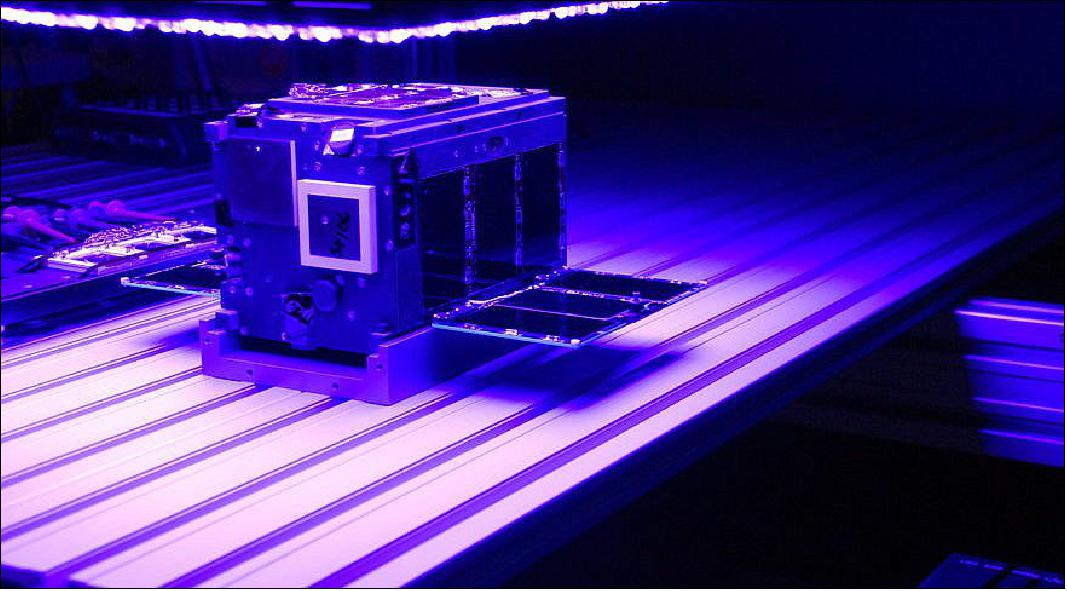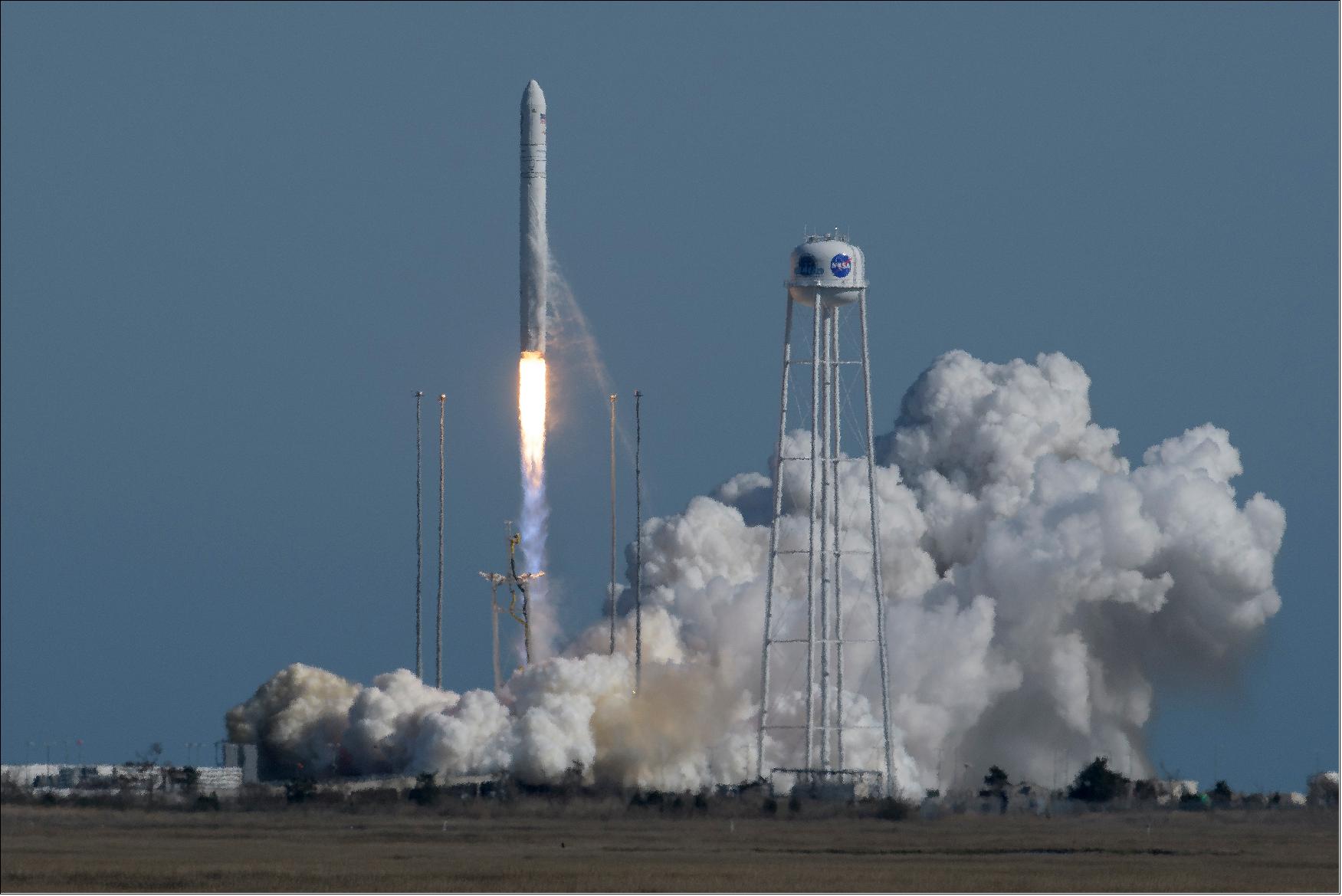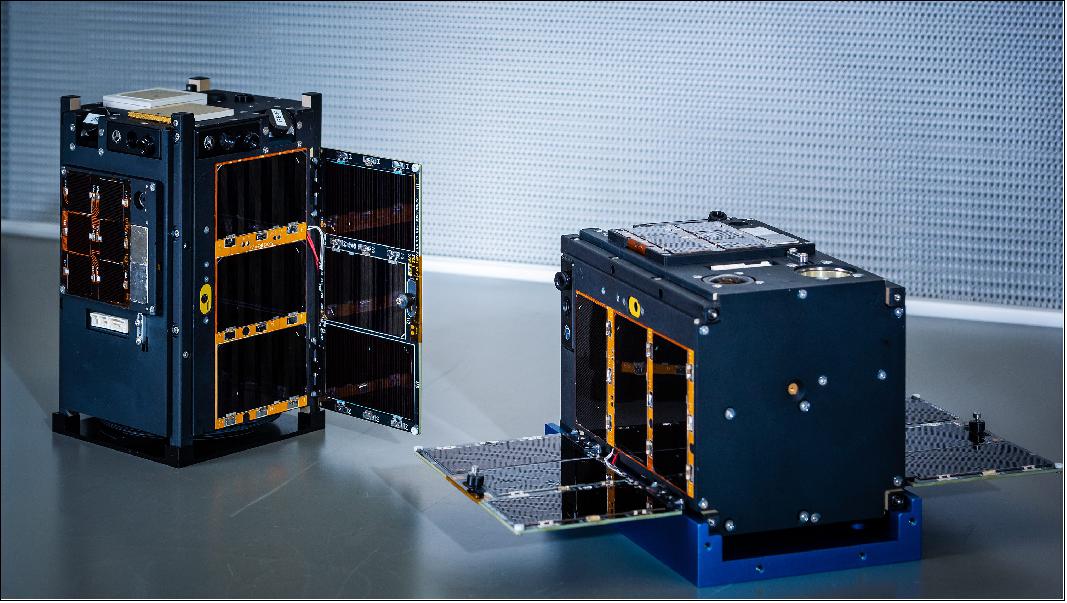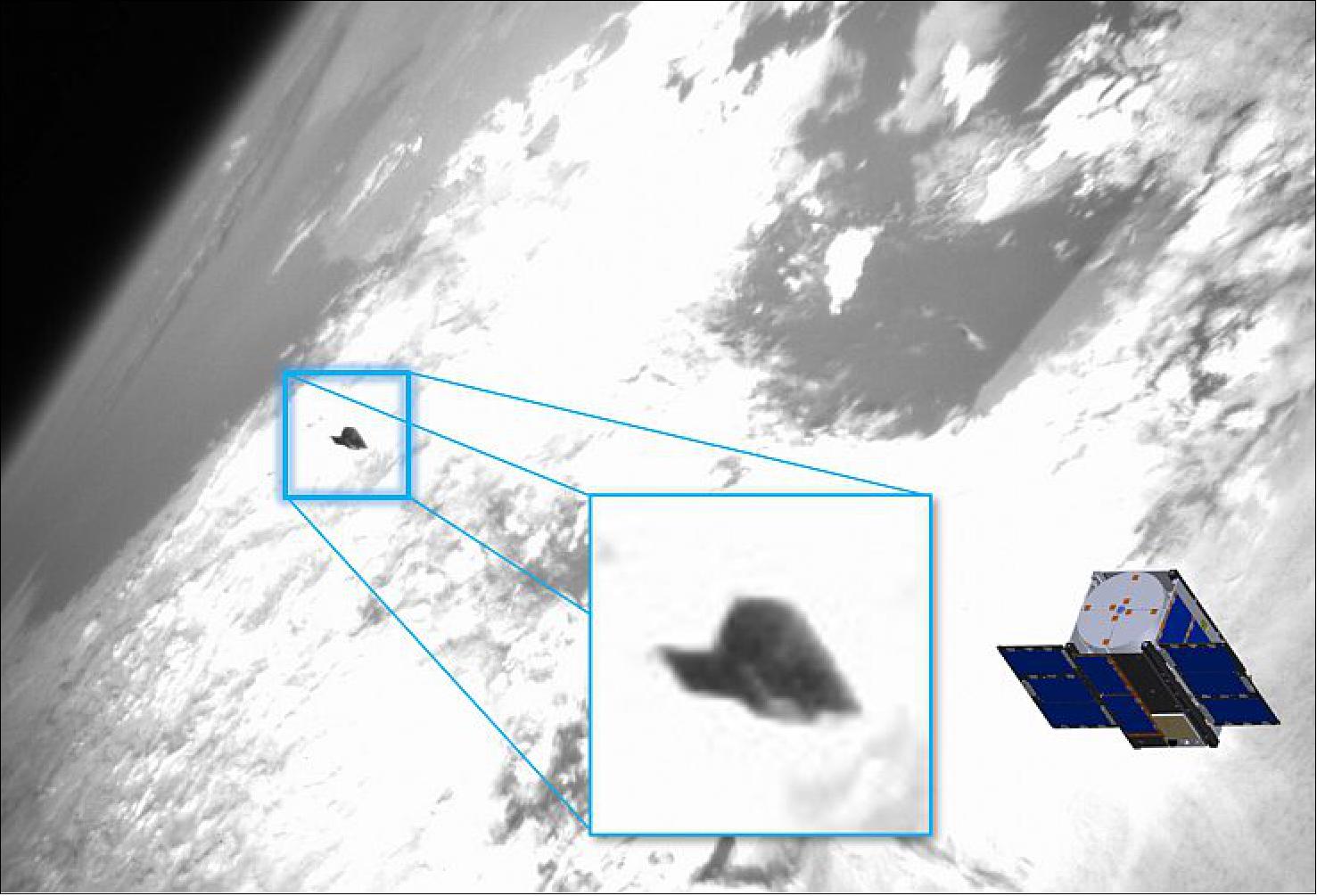AeroCube-10 (JimSat/DougSat)
Non-EO
Operational (nominal)
Technology and Research
Quick facts
Overview
| Mission type | Non-EO |
| Mission status | Operational (nominal) |
| Launch date | 17 Apr 2019 |
AeroCube-10 (JimSat/DougSat - Named after Aerospace Directors Jim Gee and Doug Holker) Mission
AeroCube-10 is a pair of 1.5U CubeSats (10 x 10 x 15 cm in size), labeled AeroCube-10A and AeroCube-10B, developed by the Aerospace Corporation of El Segundo,CA, to demonstrate several technologies. One CubeSat is carring a set of 28 deployable atmospheric probes and a laser beacon, and the other a camera and a propulsion system, which enables it to control its movements.
Mission Objectives 1)
The purpose of the mission is to demonstrate precision satellite-to-satellite pointing; deployment of atmospheric probes for in-situ measurement of air density; small-spacecraft proximity operations using propulsion from a steam thruster (no docking is planned); and solar cell performance degradation experiment that will correlate data from radiation sensors tuned to the energy levels suspected of causing damage to a drop in solar cell power output.
The AeroCube-10B spacecraft replaces the payload volume area used for the dispenser on the 10A satellite with three different payloads. One is a steam propulsion unit identical to the one in AeroCubes-7b and 7c. It will dispense water vapor to create a 4 mN thrust to change the range between the two satellites. It holds up to 30 grams of water and can affect, best case a 10 meter per second delta velocity. Water is non-toxic and the pressure inside the steam propulsion unit is at atmospheric pressure, so it is not a pressure vessel. The other is an electron and proton spectrometer called the micro-Charged Particle Telescope (µCPT). It will measure radiation flux impinging on the satellite, in specific energy levels that are suspected to cause solar cell degradation. The third payload is a sensor that will confirm when the optical beacon is impinging on the satellite. It is a light sensor, tuned to the optical beacon and amplified because the intensity is predicted to be faint.
Spacecraft
Each of the two AeroCube-10 satellites has star trackers and other attitude control verification imagers. The primary purpose of the cameras is for attitude control determination and verification. Each of the AeroCube-10 CubeSats has a mass of about 2.1 kg.

AeroCube-10B's largest payload is the propulsion unit, a warm-gas thruster that provides small changes in velocity and enables formation keeping and proximity operations with respect to AC-10A (AeroCube-10A), which cannot maneuver,” explained Joseph Gangestad, Systems Director and experiment lead. “The propulsion unit uses water as a propellant and can provide up to a total of 6 m/s of velocity change over the mission’s life.”
The AeroCube-10A spacecraft has two payloads. The first is a dispenser with a magazine of 28 identical atmospheric probes. Each probe weighs16 grams andconsist of three 98mm diameter aluminum sheets at 90 degrees to each other, effectively forming a sphere. The intent is to be lightweight and have a constant cross section, independent of orientation to the velocity direction so that atmospheric drag can be measured in-situ. RF modeling predicts that the atmospheric probes will have a radarcross section equal to 1U CubeSats, which have been tracked on-orbit many times.
The probes are dispensed individually upon command and DAS2.0.2predicts that each has a lifetime of 0.74 years when deployed from the highest altitude of 500 km. The Total Object-Time for the complement of probes according to DAS2.0.2 is 20.24 years.The second payload is an optical beacon. It is used toverify that the AeroCube-10A satellite is indeed pointing at the AeroCube-10B. It consists ofa 4 W laser diode with a 1 degree full-width-half-max beam divergence.
Launch
AeroCube-10 payload was launched on 17 April 2019 (20:46 UTC, 4:46 p.m. EDT) along with numerous other payloads to the ISS on the NASA-contracted CRS-11 (Commercial Resupply Services-11) mission Cygnus NG-11 on the Antares 230 vehicle, carrying the Cygnus cargo spacecraft of Northrop Grumman. The launch site was MARS (Mid-Atlantic Regional Spaceport) at NASA's Wallops Flight Facility in Virginia. 2) 3)
Orbit
Near circular orbit, altitude of ~ 400 km, inclination = 51.6º.


The Micro-Charged Particle Telescope (µCPT) for the AeroCube-10 Mission (Abstract)
Miniaturized electronics and application-specific integrated circuits (ASICs) are enabling a new generation of small, highly efficient instrumentation for the in situ study of space plasma environments. In this presentation, we describe the micro-Charged Particle Telescope (µCPT) being developed by The Aerospace Corporation for an experiment on the upcoming AeroCube-10 CubeSat mission. µCPT is a low size, weight, and power (SWaP) instrument designed to measure pitch angle resolved 80 keV to 3 MeV protons, 1.4 to 3.8 MeV alphas, and 50 keV to 3 MeV electrons with energy resolution ranging from 20% to 35%. The instrument includes a stack of two solid state detectors and uses a "DAPPER" ASIC-hybrid with heritage from NASA's MMS/FEEPS instruments for front-end signal processing. µCPT's total SWaP is: mass of < 300 g, power of 310 mW, and volume of 7.6 x 4.8 x 4.1 cm, making it ideal for CubeSat missions and missions of opportunity. For AeroCube-10, µCPT was designed to study particles that lead to solar cell degradation, but the µCPT was also designed specifically for versatility and ease of adaptability for future missions with different science or technical objectives. In addition to describing the design and range of options of µCPT, this presentation will also include preliminary test results of the AeroCube-10 µCPT flight and engineering models, showcasing its performance and potential for future missions. 4)
Status of the AeroCube-10 Mission
• July 22, 2020: With some technical panache, one of The Aerospace Corporation’s CubeSats maneuvered itself within 22 meters of its sibling CubeSat and snapped a series of photos while orbiting at 17,000 miles per hour. - This incredibly difficult technology demonstration, performed by a satellite the size of a tissue box, paves the way for future inspection or servicing missions. 5)
- “AeroCube-10 is by far the smallest spacecraft to have accomplished a rendezvous and proximity operation so close,” said Catherine Venturini, an Aerospace Senior Project Leader and team lead for the AeroCube-10 mission. “This operation has successfully demonstrated that the future is open for very small and cost-effective spacecraft to perform on-orbit inspection (and potentially servicing) missions, to participate in science missions that require close proximity, and ultimately to advance to docking scenarios so that nanosatellites can join in the struggle to remove space debris from orbit.”
- “AC-10B’s largest payload is the propulsion unit, a warm-gas thruster that provides small changes in velocity and enables formation keeping and proximity operations with respect to AC-10A, which cannot maneuver,” explained Joseph Gangestad, Systems Director and experiment lead. “The propulsion unit uses water as a propellant and can provide up to a total of 6 m/s of velocity change over the mission’s life.”
- Although satellites in low Earth orbit move very quickly with respect to the ground, two satellites in nearly the same orbit and nearby may seem to move very slowly relative to each other (much like two cars speeding down a highway at the same speed but in adjacent lanes). In this relative motion, one satellite can even appear to “orbit” around another.
- AC-10B entered this kind of “orbit” around AC-10A with a radius of 30 x 60 meters and used its on-board camera to take resolved images of AC-10A while orbiting from maximum to minimum range. During another close approach, AC-10B was able to take photos from a mere 22 meters away (Figure 3).
- “Making this feat possible required ingenuity across the entire team of Aerospace engineers who contributed to the design, build, and operations of AeroCube-10,” Gangestad said. “The satellites feature a GPS receiver that can pinpoint the satellites’ location to within single-digit meters even while barreling through space at 17,000 miles per hour, a propulsion system that can impart changes in velocity as delicate as four thousandths of an inch per second, an attitude control system that can point the satellites within fractions of a degree, a ground network of communications antennas that provide regular connectivity to the satellites, and mission planning tools that can model and predict the satellites’ behavior hours and days into the future with extreme precision.”
- Precise proximity operations are necessary for some of AeroCube-10’s science missions, which require spatial separation between the two CubeSats. AeroCube-10's missions include advancing the maturity of nanosatellite-scale technologies and capabilities, studying the Earth’s atmosphere via the release of small probes, and studying the radiation environment of the Earth’s ionosphere.
- Beyond its current tasks, however, AeroCube-10 demonstrates a cost-effective capability that could be used in potential future missions.
- As Gangestad put it, “The miniaturized technologies and sophisticated processes used to accomplish this proximity operation can be applied to other spacecraft and missions, so that future projects — such as free-flying inspector satellites for the International Space Station — can be accomplished in a small form factor and lower cost.”

• December 06, 2019: AeroCube 10, a pair of 1.5U CubeSats, deployed from a 3U NanoRacks deployer aboard a Cygnus cargo spacecraft in August. These craft have started to perform several of the primary missions: engaging in proximity operations, demonstrating a new thruster, and deploying atmospheric probes. 6)
- To date, a vehicle has successfully deployed one of its 28 probes, while another has performed a thruster maneuver to start a slow approach toward its sister AeroCube.
- As the complexity of AeroCubes increases, so does the need for rigorous systems engineering practice. To help address this complexity, an AeroCube modeling team used a model-based systems engineering (MBSE) approach to capture key system definition attributes.
- The requirements, concept of operations (aka CONOPS), verification activities, physical architecture, and system-level analyses were captured and interconnected in a system-definition model that serves as a “source of truth,” which, unlike traditional document-based approaches, allows systems engineers to describe and trace these attributes consistently.
- Within the systems engineering community, there are insufficient examples of MBSE being applied across a satellite lifecycle. The lessons learned from this MBSE application during development will help us advise other project leads as they integrate MBSE into their activities. Some of the key lessons learned include:
a) Modeling helps avoid pitfalls. Rigorous system-definition modeling forces early conversations among engineers, scientists, and stakeholders about structure, behavior, and requirements, helping avoid surprises later in development (e.g., during the integration and test phase).
b) Plan the SysML model structure. Create component libraries, functional packages, etc., at a general abstract level. Meta-modeling can be reused later for future projects.
c) Make key SysML model artifacts accessible. Create a method of sharing model elements with the development team, reviewers, and other stakeholders. Provide an export of artifacts into a format that everyone knows how to use, such as spreadsheets.
d) Introduce MBSE in parallel with the development process, at least initially. Although not a general rule for all situations, funding MBSE separately and gradually delegating a holistic system definition model as the source of truth are preferable to abruptly mandating a new approach to a successful, existing process.
e) Create connections between model elements. One advantage of a descriptive digital model over separate static documents is the interconnections of all the system elements rather than separate standalone artifacts.
- One example use of the MBSE implementation was that when a mission requirement was removed late during the detailed design phase, several actions were quickly performed and captured:
f) Identified specific tests that were no longer required during integration and test phase
g) Modified the CONOPS
h) Reran the system power analyses based on the new CONOPS to ensure adequate power
i) Updated lower-level requirements that derived from the removed requirement
j) Identified the subsystems, software, and components that would be affected so that all the members of the team would have the same understanding of the expected system behavior.
This fast-paced AeroCube project provided an ideal pathfinder for MBSE implementation.
• August 7, 2019: The AeroCube-10 dual CubeSat mission, packed with space experiments and technology demonstrations, was launched into orbit from the Cygnus automated cargo spacecraft after its recent departure from the international space station. 7)
- Possibly the most intriguing experiment aboard the Aerospace-funded spacecrafts was designed in-house at Aerospace and consists of hardware for a never-before-done mission. The hardware is a dispenser with a set of 28 atmospheric probes, releasable one at a time on command. These lightweight circular probes unfold into three orthogonal 98 mm diameter disks and weigh only 16 grams. They will reenter within months and will provide sensitive in-situ measurements of the variations in the density of the Earth’s thermosphere (atmosphere from about 50 to 600 miles above the Earth’s surface), which has not been studied extensively.
- The probes were the brainchild of Aerospace’s Jerry Fuller, following a hallway discussion in Chantilly with Andrew Abraham, who was working on deorbit analysis and noted that it would be good to have real-time information about conditions in the upper atmosphere. They both wondered whether CubeSats might be able to provide missing information.
- Fuller gave some thought to the problem, and that afternoon came up with concept sketches for the probes. After returning to El Segundo, Fuller got together with Dr. Rebecca Bishop of the Space Sciences Department and proposed an experiment based on the concept. Later, the concept was incorporated into the AC10 project, the deployer was designed and testing ensued on the probes to ensure they functioned correctly and could be observed clearly as they returned to Earth.
- Results from the probes should improve understanding of the dynamics in the thermosphere that affect orbital lifetimes, navigation and communications on Earth.
- Another elaborate experiment involves payloads on both of the AeroCube-10 satellites and deals with measuring radiation that could cause degradation of solar cells in space. Each satellite contains a group of space solar cells with varying radiation shielding thickness. They will provide information on how space solar cells degrade due to charged particle radiation in comparison to the degradation predicted by current models. Next to the solar cells is a pair of radiation dosimeters that will measure the electron and proton radiation flux at various energy levels.
- In addition, a device called a micro Charged Particle Telescope (µCPT) will measure proton, electron and heavy ion radiation flux at other energy levels that are suspected of causing solar cell damage.
- And who says that scientists and engineers have to be serious all the time? AeroCube-10 will also carry a payload that is strictly, or mostly, for entertainment. A wide field-of-view camera will be used to collect photographs in all directions around the spacecraft. The photos will be stitched into a 360-degree image that can be viewed with a virtual reality headset, effectively placing the viewer in space for an awesome experience.
- The AeroCube-10 pair of 1.5U CubeSats, each measuring 10 x 10 x 15 cm, are designated AeroCube-10A and AeroCube-10B. They have identical shapes and mass (within 2 grams), which will prevent them from drifting apart. This proximity allows them to demonstrate satellite-to-satellite pointing and communication and test a steam propulsion thruster aboard AeroCube-10B.
- “AeroCube-10 is not only a series of technology experiments — the two spacecraft will work together to achieve goals as well,” said David Hinkley, one of the AeroCube-10 mission designers. “Cooperative missions are a strong suit for miniature satellites.”
References
1) https://nssdc.gsfc.nasa.gov/nmc/spacecraft/display.action?id=2019-022D
2) ”Northrop Grumman Heads to Space Station with New NASA Science, Cargo,” NASA Release 19-031, 18 April 2019, URL: https://www.nasa.gov/press-release/northrop-grumman-heads-to-space-station-with-new-nasa-science-cargo
3) ”Northrop Grumman Successfully Launches 11th Cargo Delivery Mission to the International Space Station for NASA,” Northrop Grumman Newsroom, 17 April 2019, URL: https://news.northropgrumman.com/news/releases/northrop-grumman-successfully-
launches-11th-cargo-delivery-mission-to-the-international-space-station-for-nasa
4) Drew L. Turner, Justin H. Lee, Can Q. Nguyen, William C. Crain, Ariel L. Berman, J. Berhard Blake, ”The micro-Charged Particle Telescope (µCPT) for the AeroCube-10 mission,” AGU Fall Meeting, Washington D.C., 10-14 December 2018
5) ”CubeSats Get Close: Proximity Operation with Interesting Implications,” Aerospace, 22 July 2020, URL: https://aerospace.org/article/cubesats-get-close-proximity-operation-interesting-implications
6) Rob Stevens, ”First AeroCubes Defined Using MBSE Now On Orbit,” The Aerospace Corporation, 06 December 2019, URL: https://aerospace.org/getting-it-right/dec-2019/AeroCube-MBSE
7) ”Going Into Action With AeroCube-10,” Aerospace Corporation, 07 August 2019, URL: https://aerospace.org/article/going-action-aerocube-10
The information compiled and edited in this article was provided by Herbert J. Kramer from his documentation of: ”Observation of the Earth and Its Environment: Survey of Missions and Sensors” (Springer Verlag) as well as many other sources after the publication of the 4th edition in 2002. - Comments and corrections to this article are always welcome for further updates (eoportal@symbios.space).